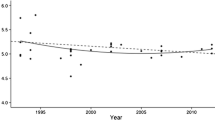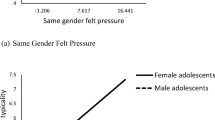Abstract
The influence of gender role identity on dating behaviors of college students was examined using the Bem Sex Role Inventory and a behavioral questionnaire constructed by the author. One hundred and ninety-seven students were classified as androgynous, undifferientated, feminine, or masculine based on their Bem Sex Role Inventory scores. A behavioral questionnaire was used to generate two self-report behavioral indexes: the masculine dating behavior and feminine dating behavior indexes. Results indicated that high-masculine individuals (androgynous and masculine individuals) scored higher on the masculine dating behavior index and that high-feminine individuals (androgynous and feminine individuals) scored higher on the feminine interactional index. The results of this study support the hypothesis that gender role identity influences self-reported dating behavior of college students.
Similar content being viewed by others
References
Alagna, S. W. Sex role identity, peer evaluation of competition, and the responses of women and men in a competitive situation. Journal of Personality and Social Psychology, 1982, 43, 546–554.
Alexander, J., & Cohen, J. Customs, coupling, and the family in a changing culture. American Journal of Orthopsychiatry, 1980, 62, 307–316.
Baumrind, D. Are androgynous individuals more effective persons and parents? Child Development, 1982, 53, 44–75.
Bem, S. The measurement of psychological androgyny. Journal of Consulting and Clinical Psychology, 1974, 42, 155–162.
Bem, S. L. Sex role adaptability: One consequence of psychological androgyny. Journal of Personality and Social Psychology, 1975, 31, 634–643.
Bem, S. L. On the utility of alternative procedures for assessing psychological androgyny. Journal of Consulting and Clinical Psychology, 1977, 45, 196–205.
Bem, S. L. Bem Sex Role Inventory: Professional Manual. Palo Alto, CA: Consulting Psychologists Press, Inc., 1981.
Bem, S. L. Gender schema theory and self-schema theory compared: A comment on Markus, Crane, Bernstein, and Siladi's “Self-schemas and gender.” Journal of Personality and Social Psychology, 1982, 43, 1192–1194.
Bem, S., & Lenney, E. Sex-typing and avoidance of cross-sex behavior. Journal of Personality and Social Psychology, 1976, 33, 48–54.
Bentler, P. M., & Speckart, G. Attitudes cause behaviors: A structural equation analysis. Journal of Personality and Social Psychology, 1981, 40, 220–238.
Bernard, L. C. Multivariate analysis of new sex role formulations and personality. Journal of Personality and Social Psychology, 1981, 41, 323–336.
Betz, N. E., & Bander, R. S. Relationship of MMPI Mf and CPI Fe scales to fourfold sex role classifications. Journal of Personality and Social Psychology, 1980, 39, 1245–1248.
Brehony, K. A., & Geller, E. S. Relationship between psychological androgyny, social conformity, and perceived locus of control. Psychology of Women Quarterly, 1981, 6, 204–217.
DeGregorio, E., & Carver, C. S. Type A behavior pattern, sex role orientation, and psychological adjustment. Journal of Personality and Social Psychology, 1980, 39, 286–293.
Fischer, J. L., & Narus, L. R. Sex roles and intimacy in same sex and other sex relationships. Psychology of Women Quarterly, 1981, 5, 444–455.
Golberg, H. The new male female relationship. New York: William Morrow and Co., Inc., 1983.
Heilbrun, A. B., Jr. Human sex-role behavior. New York: Pergammon Press, 1981.
Joesting, J., & Joesting, R. Correlations among women's views of contraception, anxiety, creativity, and equalitarianism measures. Journal of Psychology, 1974, 86, 49–51.
Orlofsky, J. L. Relationships between sex role attitudes and personality traits and the revised Sex Role Behavior Scale-2. Sex Roles, 1985, 12, 377–391.
Orlofsky, J. L., Ramsden, M. W., & Cohen, R. S. Item analysis and construction of the sex role behavior scale-2. Journal of Personality Assessment, 1982, 46, 632–638.
Rotheram, M. J., & Weiner, N. Androgyny, stress, and satisfaction: dual-career and traditional relationships. Sex Roles, 1983, 9, 151–158.
Spence, J. T., & Helmreich, R. L. Masculine instrumentality and feminine expressiveness: Their relationships with sex role attitudes and behaviors. Psychology of Women Quarterly, 1980, 5, 147–163.
Spence, J. T., Helmreich, R., & Stapp, J. Ratings of self and peers on sex role attitudes and their relation to self-esteem and conceptions of masculinity and femininity. Journal of Personality and Social Personality, 1975, 32, 29–39.
Author information
Authors and Affiliations
Rights and permissions
About this article
Cite this article
DeLucia, J.L. Gender role identity and dating behavior: What is the relationship?. Sex Roles 17, 153–161 (1987). https://doi.org/10.1007/BF00287622
Issue Date:
DOI: https://doi.org/10.1007/BF00287622




